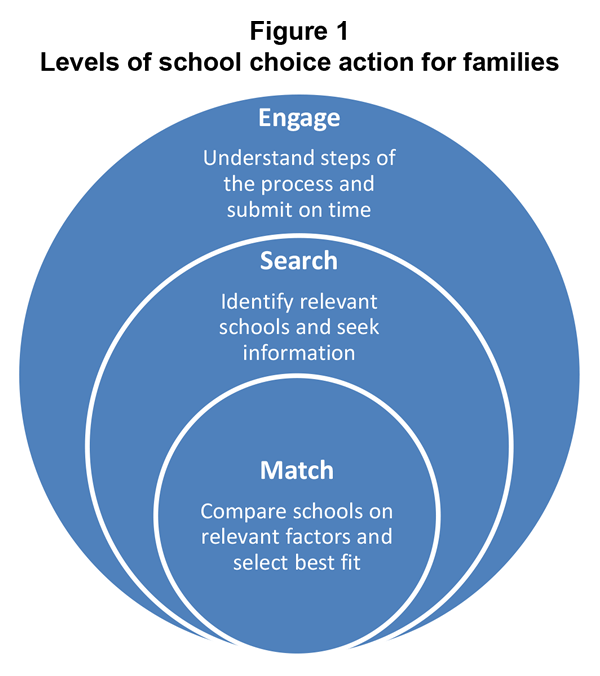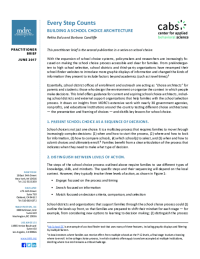Every Step Counts
Building a School Choice Architecture

This practitioner brief is the second publication in a series on school choice.
With the expansion of school choice systems, policymakers and researchers are increasingly focused on making the school choice process accessible and clear for families. From prekindergarten to high school selection, school districts and third-party organizations have revamped their school-finder websites to introduce more graphic displays of information and changed the kinds of information they present to include factors beyond academics (such as travel times).[1]
Essentially, school district offices of enrollment and outreach are acting as “choice architects” for parents and students: those who design the environment or organize the context in which people make decisions. This brief offers guidance for current and aspiring school choice architects, including school districts and external support organizations that help families with the school selection process. It draws on insights from MDRC’s extensive work with nearly 30 government agencies, nonprofits, and educational institutions around the country testing different choice architectures — the presentation and framing of choices — and distills key lessons for school choice.
1. Present school choice as a sequence of decisions.
School choice is not just one choice. It is a multistep process that requires families to move through increasingly complex decisions: (1) when and how to start the process, (2) where and how to look for information, (3) how to compare schools, (4) which school(s) to select, and (5) when and how to submit choices and ultimately enroll.[2] Families benefit from a clear articulation of the process that indicates when they need to make what type of decision.
2. Distinguish between levels of action.
The steps of the school choice process outlined above require families to use different types of knowledge, skills, and mindsets. The specific steps and their sequencing will depend on the local context. However, they typically involve three levels of action, as shown in Figure 1:
- Engage: focused on the process and timing
- Search: focused on information
- Match: focused on decision criteria, comparison, and selection

School districts and organizations that support families through the school choice process could (1) outline the levels up front, so that families are prepared to shift their mindset for each stage — for example, from considering new options to learning to decision making; (2) distinguish the process (how to assemble and submit applications) from decision making (how to search for and match to a school); and (3) offer tools for decision making at critical times that go beyond existing directories or other search tools.
3. Provide different information and support for families at each ACTION level.
A particular challenge of the school choice process is that each level of action involves different types of trade-offs. Choice architects can support families in navigating these levels by using strategic information design and structure. Each of the behavioral strategies listed below brings benefits and limitations; in this brief, we focus on potential advantages.
The Engagement Level
- Plan: Simple planning tools such as calendars and checklists can explain the process to parents in ways that prompt action. Strategically timed short reminders (whether text messages, phone calls, or postcards) can support parents in moving from intention to on-time actions at key steps of the process. Even after selecting a school, families can lose sight of deadlines for application submission. Focusing on the procedural and timing aspects of actions has proven effective in multiple settings, including several MDRC studies focused on child support payments.[3]
- Norm: To encourage families to participate in necessary steps such as attending open houses or school information events, a designer could use the power of social influence, noting how other families with similar interests or backgrounds (such as other families living in the same neighborhood or other families with children of a similar age) have successfully engaged in the choice process.[4]
The Search Level
Identifying eligible schools. Initially, districts may want to expand the list of schools a family will consider (the choice set) beyond the default school or nearby schools. Doing so may require a mix of approaches using the following behavioral principles:
- Expose: As parents seek to construct a choice set, they may need exposure to unfamiliar schools.[5] Districts may want to suggest options that families may not be aware of without presenting so many choices that families are overwhelmed. One approach is to personalize the school lists sent to families, including only schools for which the student is eligible.[6]
- Frame: How information is presented — the format and language used — influences how families act on it. If the benefits of unfamiliar schools are clear, families may be more inclined to go beyond the default and include those schools in their choice set. School systems may want to more directly highlight the potential benefits of various school options, and show that information in easy-to-absorb units (for example, that “4 out of 10” instead of “40 percent” of students go on to a four-year college).[7]
Seeking school information. Once families have constructed a relevant choice set, districts can use behavioral approaches to clarify the information families seek about specific schools, including what factors matter most to them. Districts could use the techniques below to present choices of potential factors, and then present corresponding school information for those factors.
- Reduce and simplify: Printed school directories often include large blocks of narrative text that can be difficult to understand or that present inconsistent information about schools.[8] Reducing information from a narrative to bullet points, organizing information by topic area, and using symbols in place of text and numbers is a promising approach many districts are using in their online school-finder tools.
- Ease and consolidate: In many cities, parents can select schools from multiple sectors, such as traditional public schools, charter schools, and private schools (paid for with a voucher). If parents need to use different websites and informational materials for each sector, it creates a hassle factor that can inhibit their willingness to search. Unified search and enrollment systems sponsored by school districts or third-party organizations, presenting information from various sectors in one place, offer a promising way of overcoming this obstacle.[9]
The Matching Level
Once families have compiled relevant information about schools in their choice set, they need to limit or rank schools to make a match.[10] This ranking can challenge some families because it requires them to decide which factors matter most and then to make comparisons on those factors. Behavioral techniques can offer guidance to designers trying to help families match to a school.
- Focus choices on key factors. Rather than offering comparisons on every possible factor, school systems may want to limit comparisons to the most salient ones that parents may have selected during the search process. For example, instead of showing multiple criteria, a current MDRC experiment offering different payment options for child support compares different payment options just by mode (phone, in person, and so on) and by the associated fee. This helped parents select an option while also understanding the trade-offs.
- Limit the number of choices for comparison. As with the decision factors, limiting the number of choices can help families make comparisons and ultimately take action. Among parents choosing a child care provider, a higher proportion selected a high-quality provider when presented with three personalized options, accompanied by a map, opening hours, and quality ratings, rather than existing materials that did not limit or personalize choices or show which ones were nearby. School systems can decide whether they want families to compare multiple options at once, make a series of head-to-head comparisons, or use another method to see how schools differ.
- Change the reference point or anchor for comparison. When comparing alternatives, individuals tend to compare something new against what they already know. This may make the familiar choice always seem preferable, or make characteristics such as lower graduation rates seem acceptable. School selection systems could suggest that families compare schools that meet a minimum graduation rate or a certain commuting distance, and suggest an anchor for comparison higher than they might otherwise select.
Toward a Comprehensive School Choice Architecture
To create a more coherent and consistent experience for families, policymakers, districts, and support organizations can connect interventions and systems that support them at all the levels shown in Figure 1. Choice architects and information designers can draw on MDRC’s behavioral diagnosis process to identify the different barriers families face at each of these levels and use behavioral design to create tools, like those described above, specific to those barriers.[11] Combining these approaches across levels of action could result in better school matches, and the subsequent satisfaction with school selection could result in better academic outcomes for families and districts.
* * *
The Center for Applied Behavioral Science (CABS) is an initiative that combines MDRC’s expertise in social programs with insights from behavioral science.
For more information on using behavioral principles in choice processes, email Rekha.Balu@mdrc.org. For information on school choice interventions, email Barbara.Condliffe@mdrc.org.
[1] My School DC is an example of a school finder tool that uses many of these features, including graphic displays and filtering by multiple factors.
[2] In local contexts where families can receive offers from multiple schools at the P-12 levels, a final stage involves choosing where to enroll. In the college choice process, in which students often apply to and are accepted at multiple institutions, deciding where to enroll remains a critical challenge.
[3] Glosser, Cullinan, and Obara (2016) showed that such interventions increased incarcerated noncustodial parents’ rates of renewal for order modifications to their child support payments in Washington State; various combinations of these approaches also increased the proportion of noncustodial parents in Ohio who made child support payments (Baird et al. 2015).
[4] Using social influence to prompt engagement in the child support modification and renewal process was one of several behavioral techniques used in a study in Texas that yielded positive effects on renewals.
[5] Qualitative research with disadvantaged families has shown that they sometimes lack information about the full range of schools available to them. See Bell (2009); Condliffe, Boyd, and DeLuca (2015); DeLuca and Rosenblatt (2010).
[6] Haxton and Neild (2012) found that families engaged in school choice in Philadelphia often lacked knowledge about school eligibility criteria. In North Carolina, Hastings and Weinstein (2008) examined the impact of giving parents academic quality information only for the schools that their child was eligible to attend (for example, only elementary schools for elementary school students). These simplification and personalization tactics improved the likelihood that parents would select schools with higher test scores.
[9] The OneApp system is an example of a unified enrollment system. The previously mentioned My School DC is a similar example.
[10] MDRC developed the College Match intervention to help low-income students apply to colleges that were beyond what they would normally consider but that felt like a good personal fit.
[11] MDRC’s method of mapping each step of a process to identify bottlenecks, known as behavioral diagnosis and design, has been applied in projects with multiple government agencies. See Richburg-Hayes, Anzelone, and Dechausay (2017) for a full description of the process.






